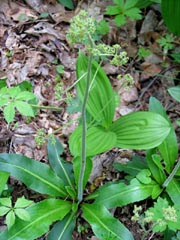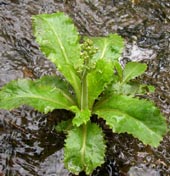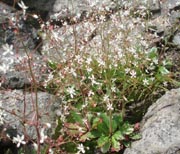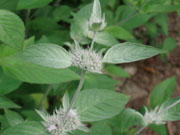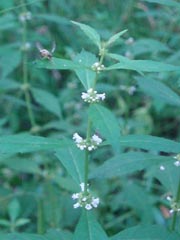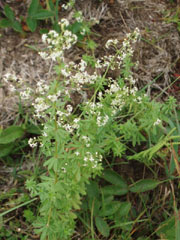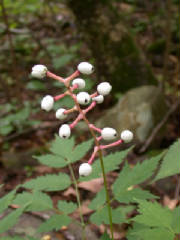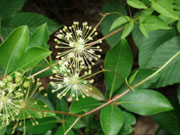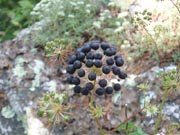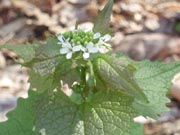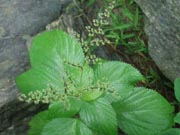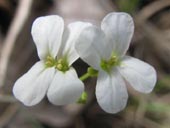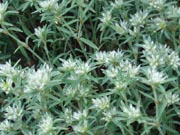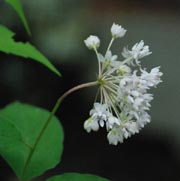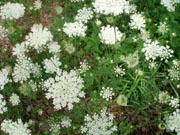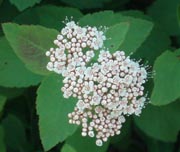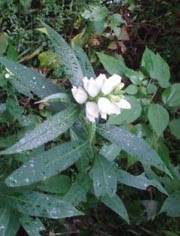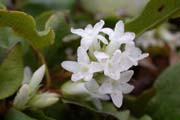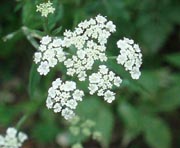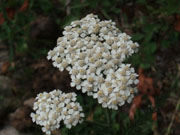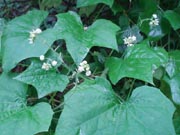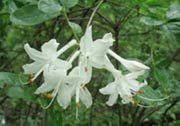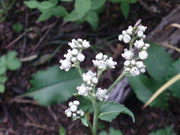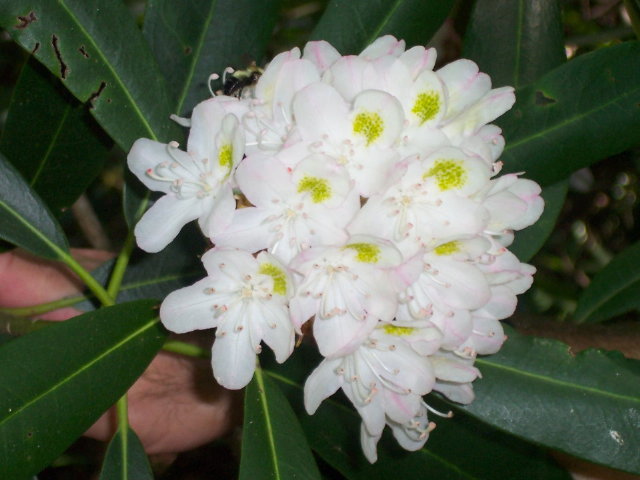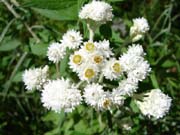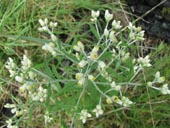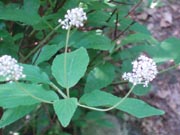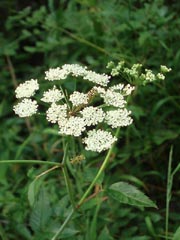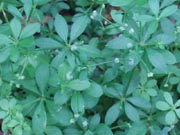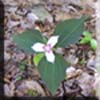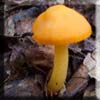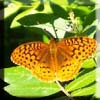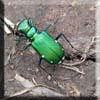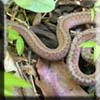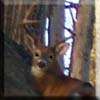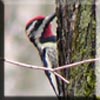|
Saxifrage Family
Early Saxifrage (Saxifraga virginiensis): Small clusters of fragrant white flowers on naked stalks from the center of oval basal leaves. Blooms April to June. As you can see they like rocks. Close up photo by David Bennick. Location: Shenk's Ferry Wild Flower Preserve, Holtwood Recreation Area, PA.
Swamp Saxiphrage (Saxifraga pensylvanica): Prefers moist places. Location G. Rhichard Thompson W.M.A. Photo by Ken Clark, 05/09. Lettuceleaf Saxifrage (Saxifraga micranthidifolia): Can grow up to 30 inches. Large, dandelion-like toothed basal leaves. Minute white flowers atop nearly naked stems. Blooms in spring. Prefers streams, seeps and other moist areas. Location: SNP, VA. Photo by Dimitri Tundra. Michaux Saxifrage (Saxifraga michauxii): Grows in rock crevices. Blooms in June. Location: Mount Rogers N.R.A., VA. Mints Hoary Mountain Mint (Pycnanthemum icanum): Flower clusters in the leaf apeces and at the top. Leaves covered in a down. Location: Duncan Knob. VA. Water horehound (Lycopus americanus): A non-aromatic mint. Clusters of small white flowers around a square stem with opposing toothed, lanceolet leaves. Thrives in wet areas. Location: Williams River, Tea Creek Backcountry, MNF, WV. White Burgamot or Basal Balm (Monarda clinopo-dia): Found in the same areas as M. didyma. Location: Williams River, Tea Creek Backcountry, MNF, WV. Virginia Mountain-mint (Pycnanthemum virginianum ): Found in dry fields and thickets. Max. height 3 feet. Flowers are very small, white and dotted with violet. Photo by Ken Clark. Bugleweed (Lycopus virginicus): Suggestive of mints but without odor. Prefers wet soil.. Bonesets/Thorough-worts When studying Eupatorium species it is best to observe the leaves as the flower heads of all are almost identical. Note the differences in the following species. Boneset (Eupatorium perfoliatum) Umbles of small, white, simple flowers. Perfoliate leaves (paired leaves joined together around the stem). |
More Bonesets/ Thoroughworts Upland Boneset (Eupatorium sessilifolium): Note that the leaves have no stems (sessile) but are not joined together as in true Boneset. Late-flowering Thoroughwort (Eupatorium serotinum): Large, lanceolet paired leaves. It is important to note the presence of leaf stems. A similar thoroughwort - E. sessilifolium has similar leaves but w/o stems (sessile). Hyssop-leaved Thoroughwort (Eupatorium hyssopifolium): Similar to E. Luecolpis (above) except leaves are in sets of four and not toothed. Round-leaved Thoroughwort (Eupatorium rotundiflorum): Broadly lanceolet sessile leaves. Up to three feet. White Snakeroot (Eupatorium rugosum): Grows in thickets in shadey woods. Heart-shaped, toothed leaves with stems. Location: Canaan Mt, CLR13, Monongahela National Forest, WV. Climbing Boneset ( or Hemp)(Mikania scandens) Not a true Boneset. Paired arrow head shaped leaves on a vine. Clusters of small white flowers similar to Eupatorium species. Mostly estuarian. Location: Merkle Wildlife sanctuary. Others Wild Madder (Galium mollugo): Alien bedstraw. Prefers open areas/roadsides. Leaves in whorls of eight. Blooms in July. Location: Mount Rogers N.R.A., VA. Horseweed (Erigeron canadensis): Tall plant with thin, willow-like leaves and clusters of inconspicuous rayless flowers. Groundsel Bush (Baccharis halimifolia): Coarde, woody shrub with thick, holly-like leaves and rayless white flowers. |
Others (Con't) Wild (Smooth) Hydrangea (Hydrangea arborescens): Close relative to the domestic variety. These small flowers are a few days away from blooming. Loves moist forest hillsides. Location: Tea Creek Backcountry, MNF, WV. Button Bush (Cephalanthus occidentalis ): Flourishes in moist areas. Location: Great Falls National Park, MD. Photo by Ken Clark. White Baneberry/Doll's eyes (Actaea pachypoda ): Clusters of fine, white flowers give rise to these in late spring/early summer. Location of berries: SNP, VA. Photo by Ken Clark. Location of flower: Tea Creek, MNF, WV. Red Baneberry (Actaea rubra) Similar to White Baneberry but the flower stalks are thinner. Flower clusters wider. Photo by Dave Bennick. Bristly Sarsaparilla (Aralia hispida): In the Ginseng family. Ovate leaves. Found in dry open woods. Summer bloomer. Bears dark purple grape-like fruit. Location: Strickler Knob, VA.
Canada Mayflower (Maianthemum canadense).: A Lily. Forms mats through rhizomes. Location: Gunpowder Falls SP, MD. Photo by Ken Clark. Garlic Mustard (Alliaria officinalis) is a very invasive alien plant. Environmental groups and government agencies conduct programs just to manually inhibit the spread of this weed. Note the heavily veined maple shaped leaves. Location: GWNF, Mau-Har Trail.
Spikenard (Aralia racemosa): In the Ginseng family. Black stem, sharply toothed broad leaves, with several umbels of small flowers. Location: Morgan Run N.E.A.
Broad-leaved Waterleaf (Hydrophyllum canadense): There are several different species of Waterleaf. Only this one possesses large, maple-like leaves. Photo by David Bennick. Lyre-leaved Rock Cress (Arabis lyrata): In the mustard family. Rosette of deeply lobed basal leaves (not shown). Prefers sandy soil. Location: Soldiers' Delight, MD. Photo by Dimitri Tundra. Silvery Nailwort (Paronychia argyrocoma): Found on rock ledges and cliffs in the mountains. Requires very little substrate for growth. Location: North Fork Mountain, WV.
|
White Milkweed (Asclepias verticillata): Broad, ovate leaves. Flowers simiiar to Poke Milkweed except they don't nod or droop and have tinges of purple instead of green. Photo by Anita Mueller. Wild Leek or Ramp (Allium tricocca): Clusters of small flowers atop naked stems. No visible leaves apparent. Grows in moist woods. Blooms June-July. Location: Otter Creek Trail, MNF, WV. Queen Anne's Lace (Daucus carota): AKA Wild Carrot. Blooms the entire summer. Roadsides and disturbed areas. Location: AFT, PA. Elder Berry (Sambucus canadensis): Very tall bush with opposite, dark green, lanceolete leaves. Grows in woods and along waterways. Wine and jams are made from its fruit. Location: Williams River, Tea Creek backcountry, MNF, WV. White Clintonia (Clintonia umbellulata): In the lily family. Tight, round cluster of fragrant white flowers atop a 8-20 inch stem. 2-5 waxy basal leaves. Blooms May - July. Produces round, black berries. Location: Cornelius Creek Tr, JNF, VA. Sweet Cicely (Osmorhiza claytoni): Fern-like leaves. Six clusters of small flowers, each on a seperate branch, radiate from a central stem. Roots have a licorice scent. Location: Tea Creek, MNF, WV. Corymbed or Dwarf Spirea (Spiraea corymbosa ): Grows to less than 2 feet in height. Clusters on dainty white flowers with pink centers. Blooms in early summer. Location: Brown Mountain Trail, SNP, VA. White Turtlehead (Chelone glabra): White but often tinged in violet. Fall bloomer. Location: Little North Mt, GWNF, VA.
Here's a
pure white version from Gifford Pinchot SP. PA.
Trailing
Arbutus (Epigaea repens): Probably the first blooming
heath in this region (March - May). Flowers may be white or
pink. A creeper. Location: Sugarloaf Mt. Photo by Ken Clark.
Erect Hedgeparsley (Torilis japonica): Also called Japanese Parsley. An aggressive invasive alien from Eurasia. Leaves are highly lobed, bottom-most ones more so. Location: Seneca Rocks Trail, WV.
Yarrow (Achillea
millefolium):
Blooms throughout the summer in sunny areas. Domestic varieties
come in assorted colors. Location: Blue Ridge Center for
Environmental Stewardship, VA. Bur Cucumber (Sicyos angulatus): Large maple-like leaves with clusters of small 5-petaled flowers arising from the leaf axils that eventually turn into burs. Location: Morgan Run N.E.A., MD |
Others (con't) Swamp Honeysuckle (Rhododendron viscosum): Not a Honeysuckle at all but rather an Azalea. As the name implies it prefers wet, sandy areas. Blooms in June. Location: Downs Park, MD. Japanese Honeysuckle (Lonicera japonica): Alien. Grows in dense thickets. Difficult to eradicate. Evergreen. Produces black berries. Photo by David Bennick. Wild Quinine (Parthenium integrifolium): Petals are very small. Dry Woods. Location: Duncan Knob, VA. 07/09.
Cotton Grass: This variety is Eriophorum virginicum. Grows in peat bogs of WV. Blooms in late summer/early fall. These were found in a couple of places on Canaan Mt, MNF, WV. Mapleleaf Viburnum, Viburnum acerifolium: Clusters of tiny white flowers bracketed by two maple-like leaves. Yields small black berries. Rhododendron (Rhododendron maximum): Grow along water,in valleys and even on mountains. Bloom in July and are white to light pink. Location: Laurel Run Trail, Great North Mt., GWNF, WV. Pearly Everlasting (Anaphalis margaritacea) - Grows along roadsides and edges. Used in dry flower arrangements. Location: Losey Rd, Quehanna Wild Area, PA. Photo by Pat Roberts. Sweet Everlasting, Catfoot (Gnaphalium obtusifolium): Similar to Pearly Everlasting, above, but lower growing, more branched with smaller, more cylindrical flowers. Location: Soldiers' Delight, MD. Photo by Dimitri Tundra. Dwarf Ginseng (Panax trifolium): 4-8 inches. Blooms May-July in moist forests. Location: AFT, PA
New Jersey Tea (Ceanoyhus americanus): Low growing shrub with round clusters of white flowers rising from leaf axils of new shoots. Colonist would make tea from the leaves. Hence the name. Blooms May - July. Location: Brown Mountain Tr, SNP, VA.
Canada Mayflower (Maianthemum canadense).: A Lily. Forms mats through rhizomes. Location: Gunpowder Falls SP, MD. Photo by Ken Clark.
Water
Hemlock (Cicuta maculata):
Grows in wetlands and along rivers and streams. Very small
amounts can kill a man. Related to Poison Hemlock given to
Socrates. Location: Williams River, Tea Creek Backcountry, MNF,
WV.
Fragrant
Bedstraw (Galium triflorum):
Leaves mostly in
whorls of six. Inconspicuous green/white flowers in groups of
three. Fragrant when leaves are dried. Downs Park, MD.
|
